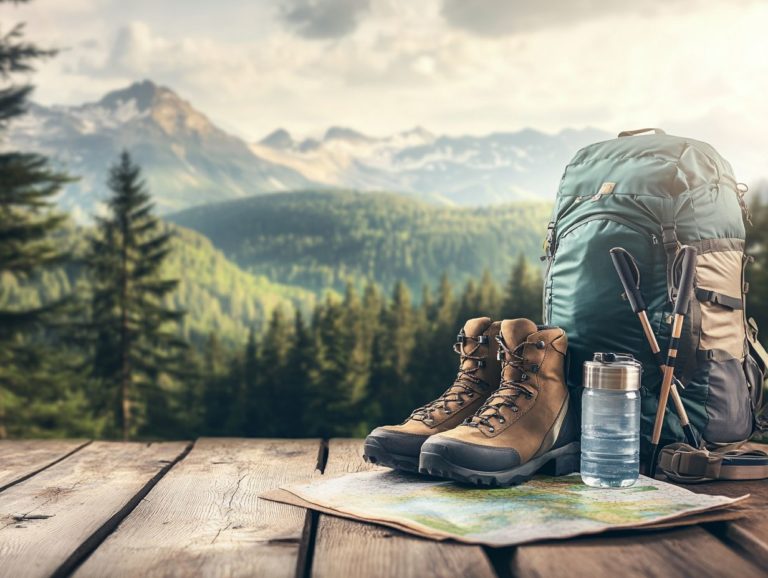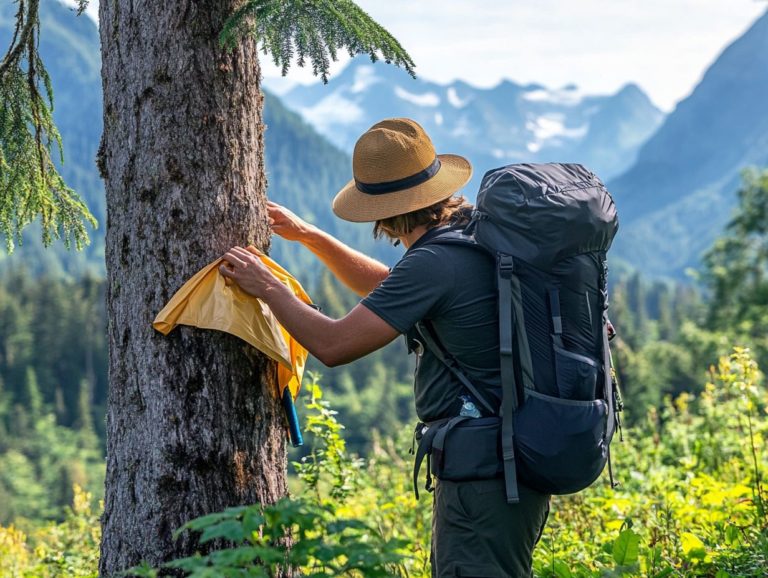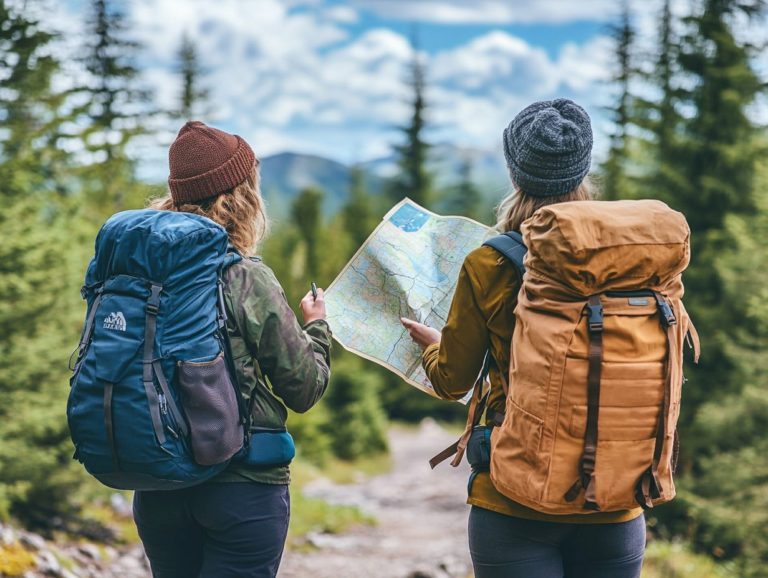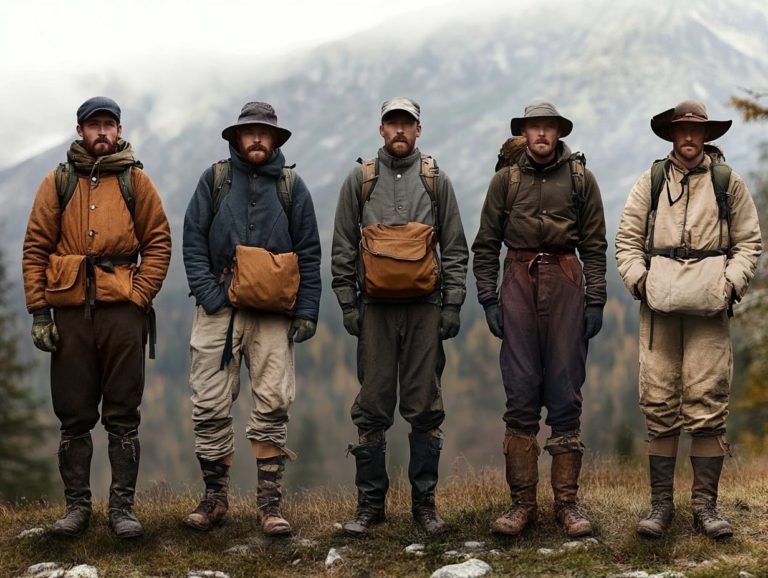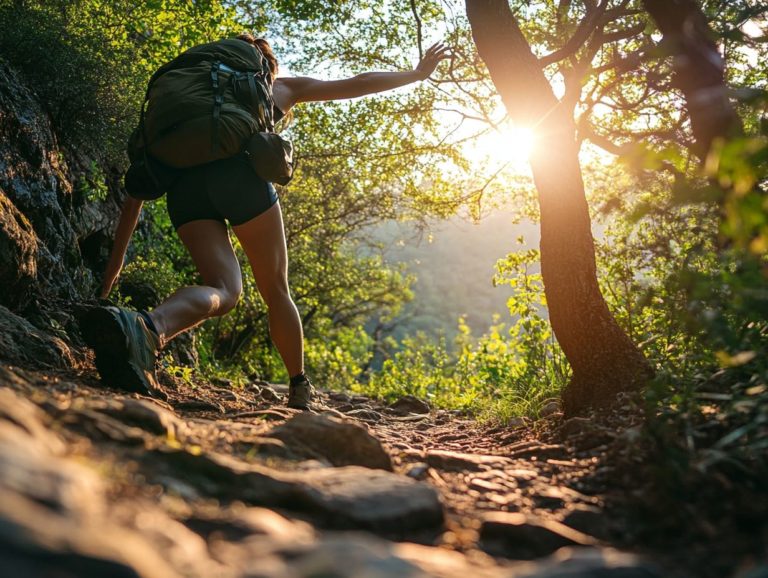Must-Have Navigation Tools for Hikers
Hiking is an exciting adventure waiting for you! Yet, without the proper navigation tools, it can swiftly transform into a formidable challenge.
As you traverse rugged terrains or meander along tranquil trails, having the right gear is crucial for your safety and direction. This article delves into the indispensable navigation tools you should consider, including:
- Topographic maps
- Compasses
- Modern GPS devices
- Essential safety items like first aid kits
- Emergency shelters
Equip yourself with the knowledge that will elevate your hiking experience to new heights!
Contents
- Key Takeaways:
- What Are the Essential Navigation Tools for Hiking?
- How Can These Tools Help Hikers Stay Safe and on Track?
- What Are the Different Types of Topographic Maps and How to Use Them?
- Why Is a Compass Still Important in the Age of Technology?
- What Are the Key Features to Look for in a GPS Device for Hiking?
- How Does an Altimeter Work and Why Is It Useful for Hikers?
- What Are the Benefits of Having a Satellite Communicator on a Hike?
- When Should a Hiker Use a Personal Locator Beacon?
- Why Is a Whistle an Important Tool for Hikers?
- What Are the Different Types of Flashlights and Which One Is Best for Hiking?
- What Should Be Included in a First Aid Kit for Hiking?
- How Can Sun Protection Help Hikers Stay Safe on the Trail?
- Why Is a Water Purifier Necessary for Hiking?
- What Are the Different Types of Multi-Tools and How to Choose the Right One for Hiking?
- Discover the Best Emergency Shelters for Your Hiking Adventures!
- How Can Insect Repellent Help Hikers Stay Comfortable on the Trail?
- What Are the Benefits of Using a Navigation App for Hiking?
- Frequently Asked Questions
Key Takeaways:
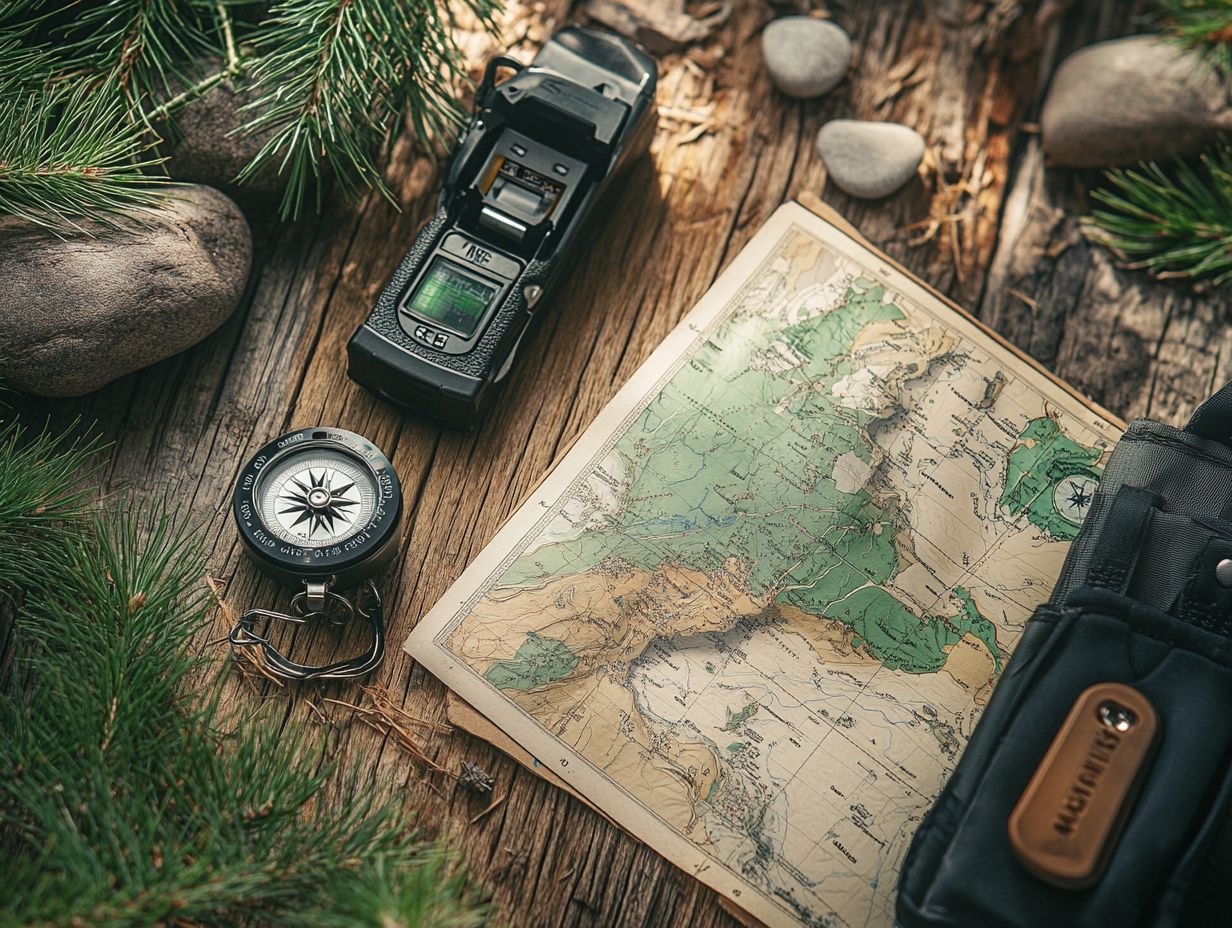
- Carry a topographic map, compass, and GPS device for accurate navigation on hikes.
- Take necessary safety precautions by carrying a first aid kit, whistle, and emergency shelter.
- Utilize modern technology, like satellite communicators and navigation apps, for added safety and convenience on the trail.
Navigating the great outdoors demands a thorough understanding of essential navigation tools that elevate both your safety and efficiency. This is especially true when tackling challenging terrains like the Great Smoky Mountains National Park.
Whether you prefer traditional maps and compasses or opt for modern GPS (Global Positioning System) units and navigational apps like Gaia GPS, having a well-rounded toolkit is crucial for developing robust navigation skills. Additionally, consider the top 10 survival gear items for hikers to enhance your outdoor preparedness.
Each tool serves an important role in ensuring effective navigation. Traditional maps provide you with a broader context of the area. Compasses help you maintain true direction a skill that becomes invaluable when visibility takes a turn for the worse.
GPS devices enable precise location tracking, allowing for swift route adjustments. Navigation apps deliver real-time updates and offline capabilities that are essential in wilderness scenarios.
Practice regularly in real-world conditions to become familiar with these tools. This will hone your ability to adapt during search and rescue missions, where every second counts. Planning your trip carefully is important; understanding key landmarks and the terrain layout aids in your orientation.
This knowledge also helps you choose safer routes, so you re ready for any adventure, no matter your experience!
Familiarity with local terrain features and key landmarks can often be the deciding factor between a smooth journey and a potentially perilous situation.
1. Topographic Maps
Topographic maps are essential tools for you as a hiker. They illustrate the terrain’s elevation, contours, and various features. This information is invaluable for effective navigation and learning navigation skills.
By mastering these maps, you can significantly enhance your trip planning, mileage calculations, and environmental navigation skills. They enable you to visualize land formations, anticipate changes in elevation, and pinpoint potential obstacles such as cliffs or rivers.
Reading these maps requires interpreting contour lines, which reveal elevation changes and gradients. This allows you to gauge the steepness of your hike. Recognizing symbols and shaded relief on the maps offers you vital insights into the landscape, ensuring you are well-prepared for the challenges ahead.
2. Compass
A compass is not just a navigational tool; it s your steadfast guide in the wilderness, enabling you to determine direction with precision. Mastering its use is essential for honing your navigation skills.
There are various types of compasses available, such as magnetic, digital, and gyrocompasses. Each operates on distinct principles to assist you in your adventures. Magnetic compasses align seamlessly with the Earth’s magnetic field, while digital versions harness GPS technology to deliver pinpoint accuracy.
In the realm of estimating your position based on your speed and direction, understanding your speed and time becomes invaluable. This allows you to estimate your position even in challenging visibility. By pairing compass use with altimeters, you can gain vital elevation readings to inform your route choices.
For a truly elevated navigation experience, merging your compass skills with topographic maps lets you cross-reference your position with confidence, setting the stage for successful exploration.
3. GPS Device
GPS devices have transformed navigation, offering precise location tracking and route planning that boost your navigation skills and enhance your safety on the trails.
Smartphone technology has changed how outdoor enthusiasts navigate challenging terrains. Popular navigation apps, such as Gaia GPS, equip both novice and seasoned hikers with useful tools.
These applications provide offline maps and include detailed maps showing the landscape s features, enabling you to make informed decisions as you explore backcountry trails.
By blending traditional navigation techniques with cutting-edge technology, you highlight the significance of having reliable tools at your fingertips. This ensures your adventures are well-planned and safe, even in remote locations.
4. Altimeter
An altimeter is an important tool for navigation that measures altitude, giving you vital information to enhance your navigation skills and situational awareness across various terrains.
Gauging elevation helps you make better decisions about your route. This is especially important in mountainous areas where trails can be hard to see.
Knowing your altitude allows you to anticipate weather changes, monitor your energy levels, and avoid potential hazards like steep drops.
This information is valuable during trip planning. By carefully charting altitude, you can estimate the time and physical exertion required for your hike. Understanding altitude readings helps you navigate with precision, ensuring you stay on course and reach your destinations safely.
5. Satellite Communicator
A satellite communicator is your essential lifeline while hiking, enabling emergency communication in remote areas where traditional signals often fail. This device greatly enhances your safety during outdoor adventures.
With these gadgets, you can send messages and alerts, ensuring swift help in unforeseen emergencies. When you venture off the beaten path, the risks increase, making a reliable communication method crucial.
Knowing you can reach out for assistance no matter where you are gives you a sense of security, allowing you to explore nature with greater confidence.
This technology turns your solo adventures into safer explorations, deepening your connection with the wilderness and enhancing your overall hiking techniques.
6. Personal Locator Beacon
A personal locator beacon (PLB) is an essential safety device for you as a hiker, enabling you to send distress signals in emergencies and greatly improving your chances of a successful rescue.
This compact, battery-operated device communicates via satellite, relaying both a distress message and your precise location to search and rescue teams. In vast wilderness areas where traditional cell phone reception can be unreliable, this technology is critical.
By carrying a PLB, you re enhancing your safety and gaining peace of mind, knowing that help is just a button push away.
This reassurance can turn a daunting hike into a manageable adventure, allowing you to explore the great outdoors with confidence and ease, especially since practice makes perfect.
7. Whistle
A whistle is a lightweight yet powerful emergency signaling tool that you should always have on hand. Its piercing sound can travel great distances, making it a crucial item for any hiker concerned about safety.
In critical situations, the high-pitched blast of a whistle can cut through nature’s sounds, drawing rescuers to your location. Unlike shouting, which can leave you hoarse and fatigued, a whistle lets you signal for help repeatedly with minimal effort.
In search and rescue scenarios, this simple tool becomes invaluable; its sound can reach far beyond the limits of the human voice, especially in dense forests or breezy conditions.
To ensure your whistle is as effective as possible, choose one in a bright color for easy visibility. It s also wise to practice using it before your adventure, so you re ready to call for help when it truly counts.
8. Flashlight
A reliable flashlight is a critical companion for hikers. It ensures safe navigation after dark and enhances nighttime adventure skills.
These portable devices come in various styles. You can choose compact models that fit in your pocket or powerful headlamps for hands-free use.
Features like adjustable brightness, water resistance, and long battery life let you select the right flashlight for any situation. Whether it s a casual evening stroll or an urgent need, the right flashlight is essential.
Being able to illuminate your path in the dark helps you avoid obstacles and call for help if needed. Investing in a quality flashlight is a must-have for every hiker!
9. First Aid Kit
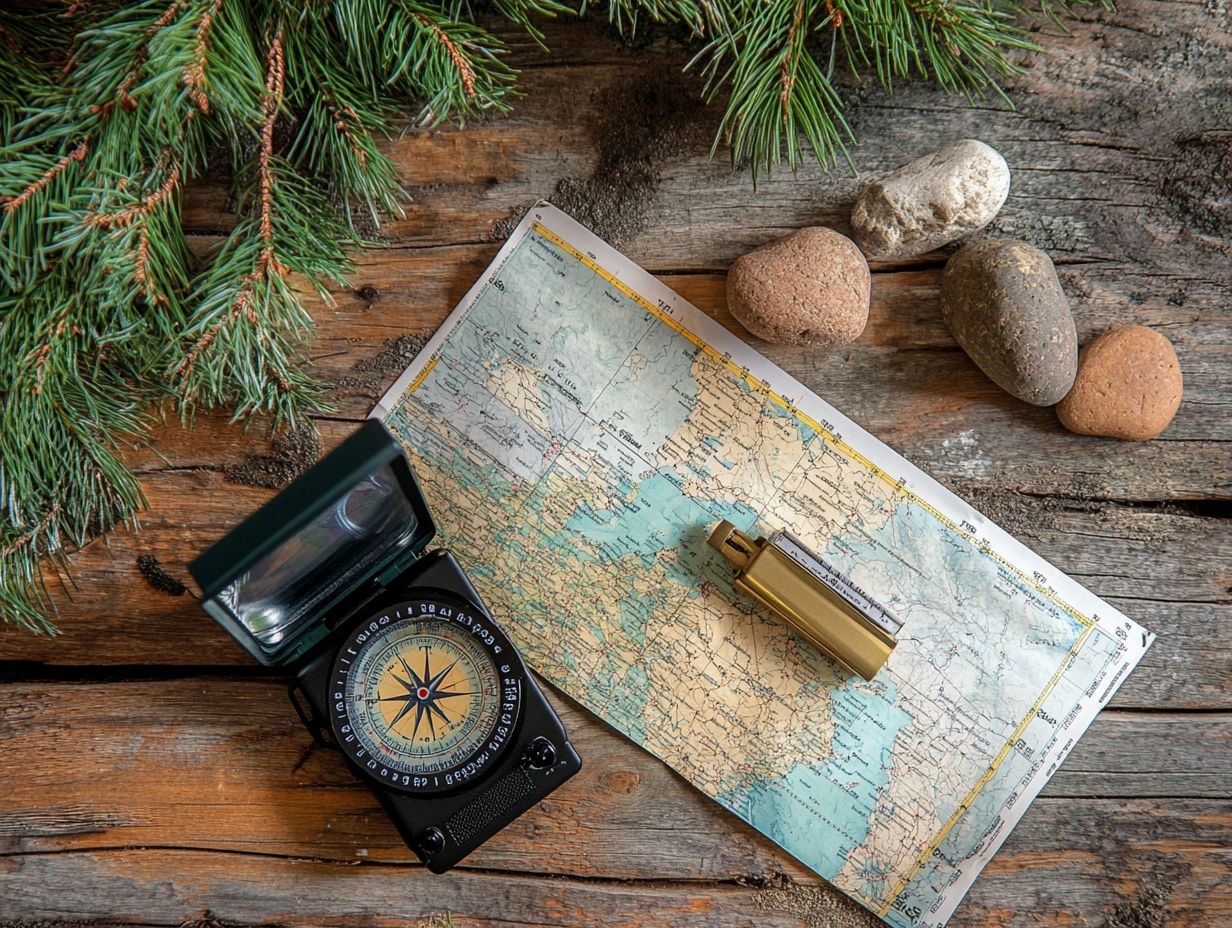
A well-stocked first aid kit is essential for emergency preparedness as a hiker. It provides the necessary supplies to address injuries and ensure your safety on the trails.
This compact, portable toolbox can significantly influence how efficiently you handle unexpected mishaps. Typically, it includes a variety of items, such as adhesive bandages, antiseptic wipes, gauze pads, and handy tools like tweezers and scissors.
Having these supplies at your fingertips helps you treat minor scrapes or insect bites. It also aids in stabilizing more serious injuries until professional assistance is available.
For those exploring remote areas, being well-prepared can minimize risks. This offers reassurance, allowing you to immerse yourself in the beauty of nature without the constant worry of potential hazards.
10. Sun Protection
Sun protection is essential for hikers, as prolonged UV exposure can lead to serious health concerns. It s a key component of your overall hiking safety.
When you’re out in open landscapes, the sun s intensity can be particularly brutal. To safeguard your skin, consistently apply sunscreen that protects against both UVA and UVB rays, remembering to reapply every two hours or after sweating.
Alongside sunscreen, wearing a wide-brimmed hat offers extra protection for your face and neck, significantly reducing the likelihood of burns. Lightweight, UV-blocking clothing can further enhance your defense against harmful rays.
Being proactive about sun protection elevates your comfort during outdoor adventures. It also safeguards your health for many more excursions to come.
11. Water Purifier
A water purifier is an essential companion for hikers, ensuring access to safe drinking water and significantly enhancing hydration during outdoor adventures.
Understanding the various types of water purifiers enables you to make well-informed choices. You ll find mechanical filters designed to remove bacteria and parasites, ultraviolet (UV) purifiers that neutralize harmful microorganisms, and chemical treatments that effectively eliminate pathogens.
Each method has its advantages, and your choice will often depend on the specific conditions of your hike. Safety considerations are paramount; selecting a purifier that adheres to quality standards and is suitable for the local water sources is critical.
When choosing the right purifier, evaluate factors such as weight, ease of use, and the volume of water you’ll need.
12. Multi-Tool
A multi-tool is an essential piece of outdoor gear that combines several functions, significantly enhancing your convenience on the trail.
With features like blades, screwdrivers, can openers, and pliers, this handy device can handle a wide range of tasks. From simple repairs to more complex challenges in the wilderness, a multi-tool is invaluable. For example, if you discover a tear in your tent, a multi-tool allows for quick patching without the hassle of digging through your gear.
An unexpected encounter with wildlife can happen. A multi-tool can help you secure your gear or even prepare a meal. Its lightweight design and compact form make it easy to carry, ensuring that your peace of mind is always within reach, no matter what nature has in store for you.
13. Emergency Shelter
An emergency shelter is essential survival gear for hikers, offering protection from the elements and reducing risks in unexpected situations.
These shelters come in various forms, including tent shelters, tarp setups, and compact sleeping bags. Each type caters to specific needs and environmental challenges. Tent shelters provide a robust structure that can endure harsh weather, while tarp setups are the lightweight option for those who prefer to travel swiftly. On the other hand, compact sleeping bags are designed for individual use, providing a practical solution for quick protection.
Understanding the benefits of each type can greatly enhance your survival chances. A reliable shelter keeps you warm and dry in emergencies, bringing peace of mind when the unexpected occurs.
14. Insect Repellent
Insect repellent is an essential companion for your hiking adventures, protecting you against pesky pests that can disrupt your experience.
You’ll find various options on the market, including DEET-based sprays, picaridin, and natural options like citronella and eucalyptus oils. Each type offers varying levels of effectiveness tailored to combat specific insects, whether it’s mosquitoes, ticks, or flies.
For outdoor enthusiasts, comfort is paramount. A reliable repellent keeps those annoying bugs at bay, allowing you to immerse yourself in nature and enjoy the breathtaking views while exploring.
A navigation app on your smartphone can elevate your hiking experience, providing real-time insights and ensuring safety on unfamiliar trails.
By using advanced GPS technology, these applications enable you to track your routes, monitor your altitude, and even pinpoint your location if you happen to get lost.
Popular choices like Gaia GPS provide detailed topographical maps and the ability to download maps for offline use, which is essential when you re exploring areas with limited signal reception.
These apps often include features like waypoints and trail recommendations, making it easier to discover scenic viewpoints and local landmarks.
Embracing this technology deepens your connection with nature while giving you peace of mind, knowing that help is just a tap away.
How Can These Tools Help Hikers Stay Safe and on Track?
The integration of essential navigation tools enhances your safety and helps you stay on track during wilderness adventures.
Using GPS devices, compasses, and detailed maps drastically reduces the chances of becoming disoriented. Imagine this: during a sudden storm, a hiker lost in a dense forest turned to their GPS device, which provided the quickest route back and highlighted safe zones along the way.
Real-life examples underscore this importance. In one case, a group stranded in the mountains relied on their map-reading skills to guide search and rescue teams to their location. This illustrates that proper trip planning, combined with reliable navigation tools, is essential for confidently tackling the great outdoors, ultimately enhancing both your safety and enjoyment.
Remember to pack these essential tools for your next hike!
What Are the Different Types of Topographic Maps and How to Use Them?
Topographic maps come in various forms, each tailored to meet specific needs. These maps provide essential information to improve your navigation skills and enhance your hiking experience.
Take the traditional topographic map, for example. It features contour lines that illustrate elevation changes, allowing you to discern steep terrains from gentle slopes.
Some maps cater to specific activities like hiking, highlighting trails, campsites, and potential hazards you might encounter. There are also shaded relief maps, which offer a three-dimensional perspective, helping you visualize the landscape with greater clarity.
By mastering the art of reading these diverse maps, you can plan your routes more effectively, anticipate challenges, and elevate your overall outdoor experience all while cultivating a sense of confidence during your adventures on the trails.
Why Is a Compass Still Important in the Age of Technology?
Despite advancements in technology, a compass remains a critical navigational tool, providing reliability and essential skills that digital devices simply cannot replicate.
Its straightforward mechanics are invaluable, especially for hikers venturing into remote areas where battery life and signal can falter. Imagine traveling through dense forests or rugged mountains a compass can effortlessly guide you back on course when GPS devices let you down, especially in dead reckoning, where you estimate your position based on your last known location.
In situations such as sudden storms that disrupt satellite signals, the compass shines as your steadfast guide, ensuring you maintain your bearings even when modern technology takes a backseat.
What Are the Key Features to Look for in a GPS Device for Hiking?
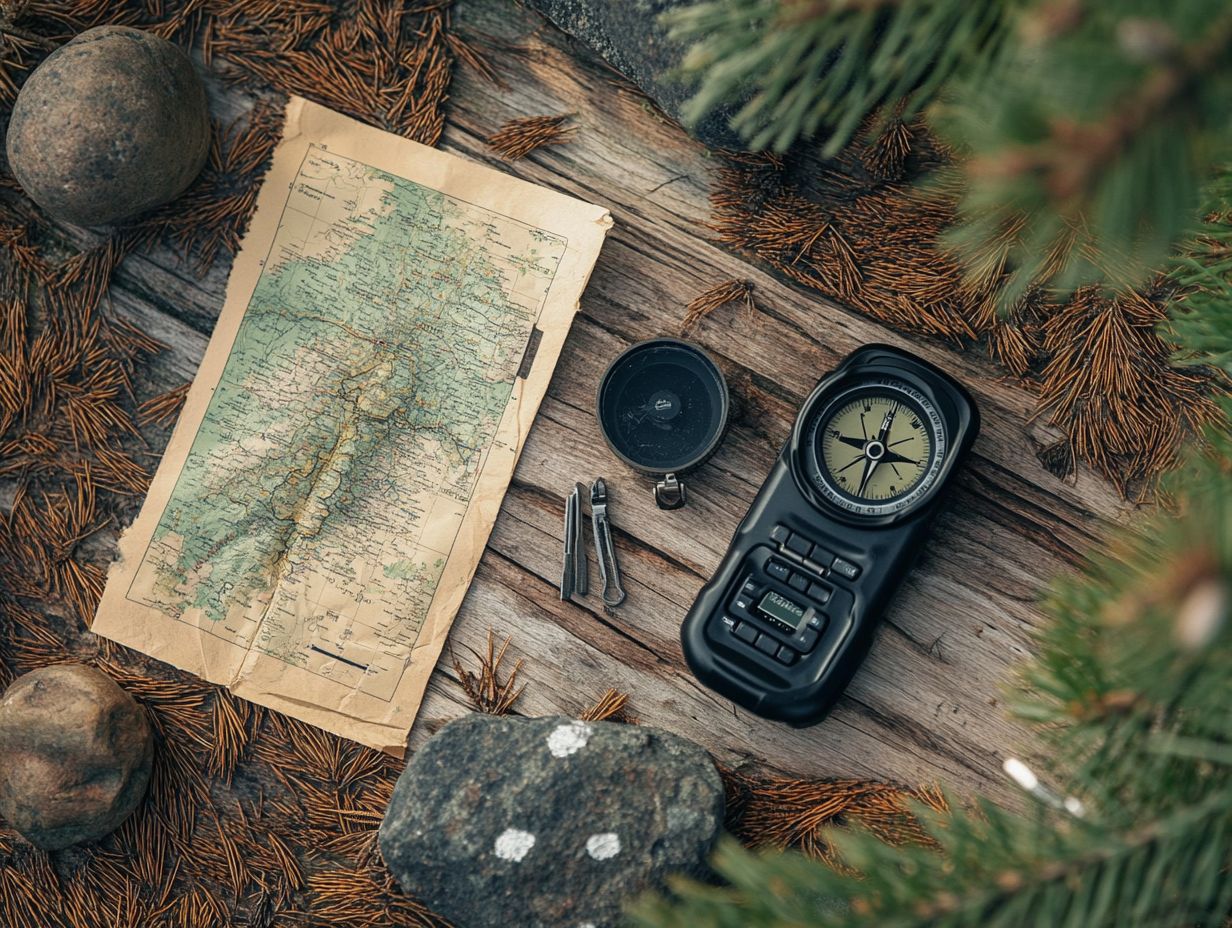
Choosing the right GPS device can make your hiking adventures unforgettable. When selecting a GPS device for your hiking adventures, it s essential to consider several key features that ensure it meets your navigation needs and elevates your hiking experience.
First and foremost, battery life is paramount; a dependable, long-lasting battery means you can explore for extended periods without the anxiety of running out of power.
Next, waterproofing is crucial for outdoor excursions, as unpredictable weather can quickly render a device useless. You want something that can endure rain or splashes without missing a beat.
Look for compatibility with various navigational apps to access different maps and receive real-time updates. This capability can be invaluable when traversing unfamiliar terrain.
Together, these features not only offer reliability but also provide peace of mind, enabling you to immerse yourself in the beauty of nature rather than fretting over the technology that s meant to guide you.
How Does an Altimeter Work and Why Is It Useful for Hikers?
An altimeter is a critical tool that measures altitude, offering hikers crucial insights to enhance their navigation skills and inform their decision-making on the trail.
Grasping how this instrument works is vital for outdoor enthusiasts. Altimeters typically measure altitude by detecting changes in atmospheric pressure, which allows them to provide accurate readings of your elevation above sea level.
This capability becomes particularly important when tackling steep terrains, as it enables you to monitor your ascent or descent and estimate the remaining distance to your next waypoint.
To make the most of your altimeter, calibrate it at known reference points such as trailheads or summits. Regularly verify its accuracy against maps or GPS devices, allowing you to seamlessly integrate traditional and modern navigation methods into your hiking experience.
What Are the Benefits of Having a Satellite Communicator on a Hike?
Having a satellite communicator on your hike brings a wealth of advantages. It especially improves your safety through reliable emergency communication and gives you peace of mind while navigating remote areas.
This ingenious device ensures that you stay connected, even when you are surrounded by the most secluded landscapes without cellular signals. In an emergency, being able to send distress signals can be a lifesaver, enabling rescue teams to locate you quickly.
You can also use the communicator to check in with friends or family, reassuring them that you are safe and on course. For avid adventurers, this tool elevates your hiking safety, turning potentially risky outings into enjoyable experiences free from unnecessary concerns.
When Should a Hiker Use a Personal Locator Beacon?
A personal locator beacon (PLB) is your best friend in emergencies when you need immediate help. It is an essential tool for ensuring your safety in the great outdoors.
Imagine hiking and sustaining an injury far from the nearest access point. In that moment, activating a PLB can signal distress to search and rescue teams, significantly reducing their response time. When sudden severe weather rolls in or you find yourself lost on unmarked trails, this device truly becomes your lifeline, especially when regular communication methods fail.
Remember to use your beacon only in true emergencies and ensure it s visible to satellites. A PLB complements other strategies, like carrying a two-way radio a device that lets you talk to someone far away or a smartphone. However, its unique advantage lies in its dedicated satellite communication capability, making it a critical tool in your safety arsenal.
Why Is a Whistle an Important Tool for Hikers?
A whistle is a small yet powerful tool that can be a game-changer for you as a hiker in distress. It provides an effective means of emergency signaling to facilitate search and rescue efforts.
While you might instinctively rely on shouting or visual signals, those methods can easily fail due to fatigue or unpredictable conditions. A whistle, however, can project sound over long distances, cutting through the chaos and ensuring your call reaches potential rescuers.
In dense forests or rugged terrains, the sharp tone of a whistle is often more audible than your voice. If you need help, blow three short blasts to indicate distress or use a continuous blast to grab attention. This straightforward method can save lives by instantly communicating urgency in dire circumstances.
What Are the Different Types of Flashlights and Which One Is Best for Hiking?
Choosing the right flashlight for your hiking adventures is essential for ensuring safety and enhancing navigation skills during low-light moments on the trail.
With so many options, it s crucial to evaluate the different types of flashlights best suited for the outdoors. High-lumen flashlights provide powerful brightness that can be invaluable when you need to illuminate a dark path or signal for help. Compact models with extended battery life fit easily into your backpack without taking up much space, even if they might not shine as brightly.
Durability is another key feature to consider, as hiking often exposes your gear to harsh conditions. That s why rugged, water-resistant flashlights are preferred by many outdoor enthusiasts. Ultimately, having a reliable flashlight can make all the difference in navigating safely and confidently after sunset.
What Should Be Included in a First Aid Kit for Hiking?
A well-stocked first aid kit is an essential element of your emergency preparedness as a hiker. It provides you with the necessary supplies to address injuries and health concerns that may arise during your outdoor excursions.
Having these supplies at your fingertips can significantly influence the outcome of various situations, ranging from minor cuts and scrapes to more serious issues like sprains or allergic reactions. Pack these crucial supplies to tackle any mishap with confidence!
- Antiseptic wipes for cleaning wounds
- Adhesive bandages for covering injuries
- Gauze and medical tape for larger cuts
- Pain relief medication and antihistamines to alleviate discomfort and manage allergic responses
- A compass or whistle for emergencies, ensuring effective communication and navigation
Prioritizing preparedness promotes your safety and boosts your confidence. This allows you to fully immerse yourself in the beauty of nature while minimizing health risks.
How Can Sun Protection Help Hikers Stay Safe on the Trail?
Effective sun protection is essential for you as a hiker. It allows you to guard against harmful UV exposure while ensuring your outdoor adventures are both safe and enjoyable.
Considering the unpredictable nature of the sun’s rays, it s vital for you to adopt a varied methods to shield your skin. Applying a broad-spectrum sunscreen with a suitable SPF is a fundamental step; it offers crucial protection against both UVA and UVB rays, which are invisible rays that can harm your skin.
Beyond sunblock, opting for lightweight, long-sleeved clothing can greatly diminish the risk of sunburn. Donning a wide-brimmed hat not only provides shade but also further protects your face and neck. These precautions are pivotal in preventing heat-related illnesses, ensuring that every trek into nature is as much about fun as it is about safety.
Why Is a Water Purifier Necessary for Hiking?
A water purifier is an essential piece of hiking gear that guarantees your access to clean drinking water. This promotes hydration and enhances safety during your outdoor adventures.
In the wilderness, where resources may be limited, having a reliable water purification system can significantly reduce your risk of waterborne illnesses. Various methods of water purification like filtration, ultraviolet light, and chemical treatments each come with their own set of advantages and limitations.
While filters are great at tackling bacteria and protozoa, they might not be effective against viruses. This is where a UV purifier shines, offering a more comprehensive solution for complete safety.
Don t risk your adventure! Ensure you have clean water to keep you hydrated. Staying hydrated is crucial for maintaining your energy levels and cognitive function while hiking.
What Are the Different Types of Multi-Tools and How to Choose the Right One for Hiking?
Choosing the right multi-tool for hiking can significantly enhance your convenience and preparedness, enabling you to tackle a variety of tasks and challenges that may arise on the trail.
These versatile tools come in a range of styles, from compact pocket-sized gadgets to robust, full-sized versions packed with an array of features. Consider some common types:
- Pliers-based multi-tools provide gripping power and leverage, making them ideal for tougher jobs.
- Knife-oriented models are specifically designed for cutting tasks.
It s also crucial to think about the additional tools included, such as screwdrivers, can-openers, and specialized blades. When selecting the perfect multi-tool, reflect on your specific hiking needs.
Whether you require lightweight portability for long treks or a more rugged design for challenging terrains, choosing a tool that aligns with your hiking environment can truly make all the difference. Consider adding some of the top 10 hiking safety gadgets to your gear. Make sure you pack these essentials before your next hike!
Discover the Best Emergency Shelters for Your Hiking Adventures!
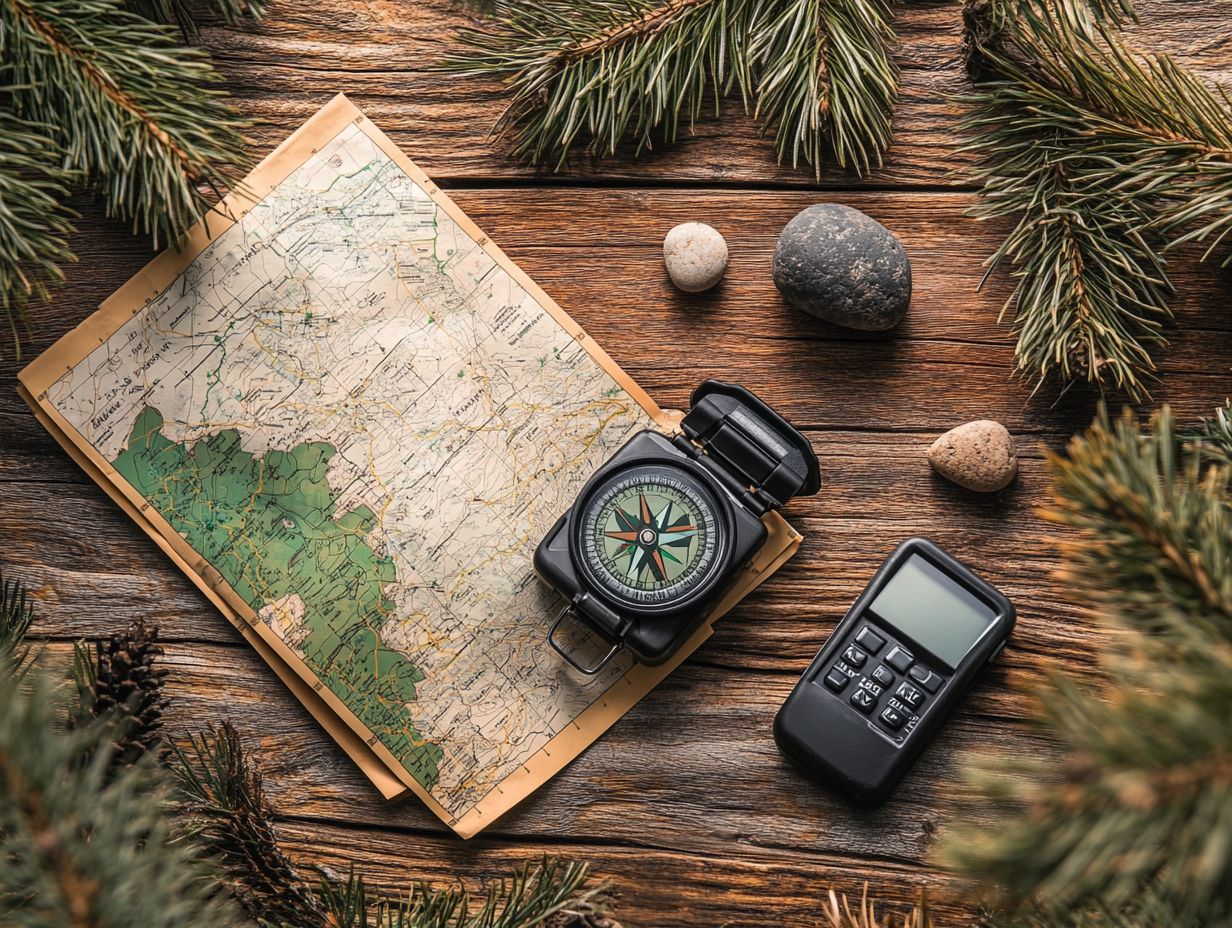
Emergency shelters are your lifeline in the wild they protect you and keep you safe! They are essential elements of your survival gear as a hiker, offering protection from the elements and enhancing your safety during unexpected situations.
These shelters come in various forms, such as bivvy bags, tarp setups, and portable tents. Each is tailored to meet the demands of different environments and emergency scenarios. A bivvy bag is an ideal choice if you’re looking for a lightweight option in remote areas, providing warmth and rapid deployment when time is crucial. A tarp can serve multiple purposes, shielding you from rain or sun while being easily set up among trees.
Portable tents elevate your comfort and security during prolonged emergencies. By integrating an emergency shelter into your hiking equipment, you not only boost your confidence but also ensure you’re prepared for unexpected weather changes and unforeseen injuries. This highlights the critical role these shelters play in your overall outdoor safety.
How Can Insect Repellent Help Hikers Stay Comfortable on the Trail?
Insect repellent is a critical companion for hikers, ensuring your comfort and allowing you to fully savor your outdoor adventures without pesky insects interrupting your experience.
The effectiveness of these repellents can vary considerably based on the main substances that repel insects, such as DEET, picaridin, or natural alternatives like citronella oil. Each type serves a distinct purpose in keeping those irritating bugs away, which is essential when you’re walking through the woods. By preventing unwanted bites, these repellents create a significantly more enjoyable hiking experience.
A comfortable trek invites you to immerse yourself in the breathtaking beauty of nature, allowing you to appreciate the sights and sounds around you without the constant annoyance of mosquitoes or ticks.
Using a navigation app like Gaia GPS on your smartphone can significantly elevate your hiking experience. With live tracking, detailed maps, and safety features that traditional tools may lack, you’re equipped for adventure!
These apps also allow you to download maps for offline use, ensuring you won’t lose your way, even in areas without cellular service. Their user-friendly interfaces make it easy for both seasoned adventurers and casual hikers to access vital information without any hassle.
While traditional tools like compasses and printed maps have their place, the dynamic nature of navigation apps enhances these methods by providing up-to-the-minute updates on trails and weather conditions. This blend ultimately leads to a more secure and enjoyable outdoor experience.
Frequently Asked Questions
The must-have navigation tools for hikers include a map, compass, GPS device, altimeter, whistle, and a watch.
A map shows you where to go and helps you stay on the right path.
A compass uses the Earth’s magnetic field to determine direction and helps hikers stay on track, even in areas with no visible landmarks.
A GPS device uses satellite technology to pinpoint your location, track your route, and provide real-time navigation information.
Why is an altimeter useful for hikers?
An altimeter measures altitude, helping hikers determine their location on a map, track elevation changes, and avoid getting lost in fog or low visibility conditions.
A whistle can be used as an emergency signal, helping hikers attract attention and get help if they become lost or injured on the trail.
Ready to gear up for your next adventure? Check out our essential hiking tips!

